2022 EDUCATIONAL PLAN

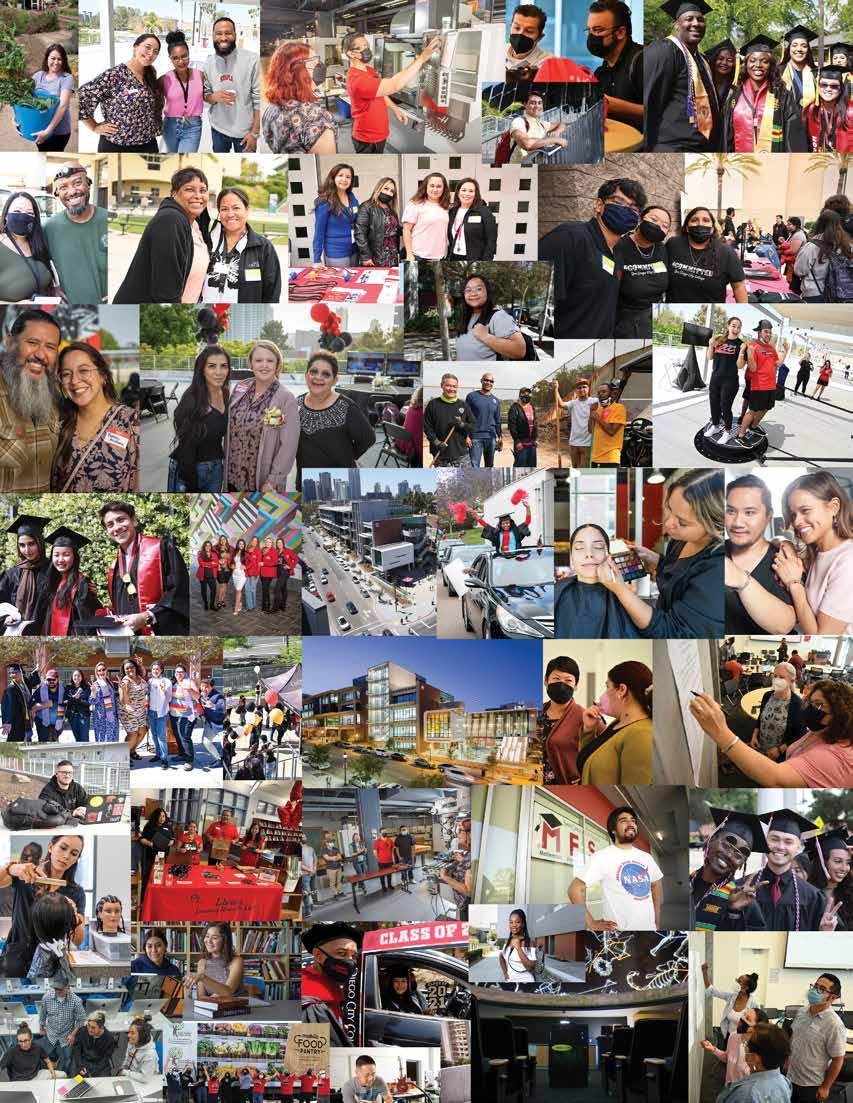
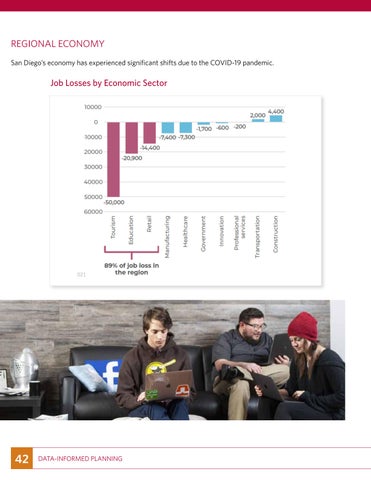





Among one of the largest of California’s 73 community college districts, the San Diego Community College District (SDCCD) serves approximately 100,000 students annually at its three credit colleges, San Diego City College, Mesa College, Miramar College, and the seven non-credit campuses of San Diego College of Continuing Education. The District proudly serves over 7,000 active-duty military personnel, veterans, and dependents.
The SDCCD is governed by its five-member, locally elected Board of Trustees and three student members serving on a rotating basis. SDCCD trustees are elected in even-numbered years to four-year terms by the voters of San Diego. The District’s chief executive officer, the Chancellor, is responsible for carrying out the policies approved by the Board of Trustees. The District follows a participatory governance structure that allows constituent groups to participate in all planning processes.
The credit colleges offer associate degrees, and the College of Continuing Education and the credit colleges offer career technical certificates that prepare students for transfer to universities and/or career pathways for gainful employment. In addition, Mesa College offers a bachelor’s degree in Health Information Management as part of California’s Baccalaureate Program. The SDCCD maintains active partnerships with local industry, the community, military, and educational institutions to ensure students have clear pathways to careers and the next stage of their education.
The District and its graduates had a combined economic benefit to the region of $3.6 billion during the 2020-21 fiscal year. The District’s credit colleges and College of Continuing Education each provide vibrant campuses, offering accessible, diverse learning experiences in a multicultural setting that both reflects and meets the needs of the community. With a focus on innovation, access, and excellence, the SDCCD is redefining the community college experience.
SDCCD serves approximately 100,000 students annually at its three credit colleges.
The San Diego Community College District is governed by its five-member, locally elected Board of Trustees and a student board member. The five trustees are elected in even-numbered years to four-year terms by the voters of San Diego.

CARLOS O. CORTEZ, PH.D. Chancellor
RICKY SHABAZZ, ED.D. President, San Diego City College
ASHANTI HANDS, ED.D. President, San Diego Mesa College





P. WESLEY LUNDBURG, PH.D. President, San Diego Miramar College
TINA M. KING, ED.D.
President, San Diego College of Continuing Education

BONNIE ANN DOWD, ED.D. Executive Vice Chancellor, Business & Technology Services
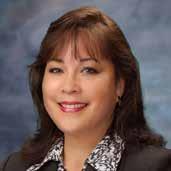


GREGORY A. SMITH Vice Chancellor, Human Resources
SUSAN TOPHAM, ED.D. Vice Chancellor, Educational Services
JOEL PETERSON, PH.D. Vice Chancellor, Facilities Management

JACK BERESFORD Director, Communications and Public Relations

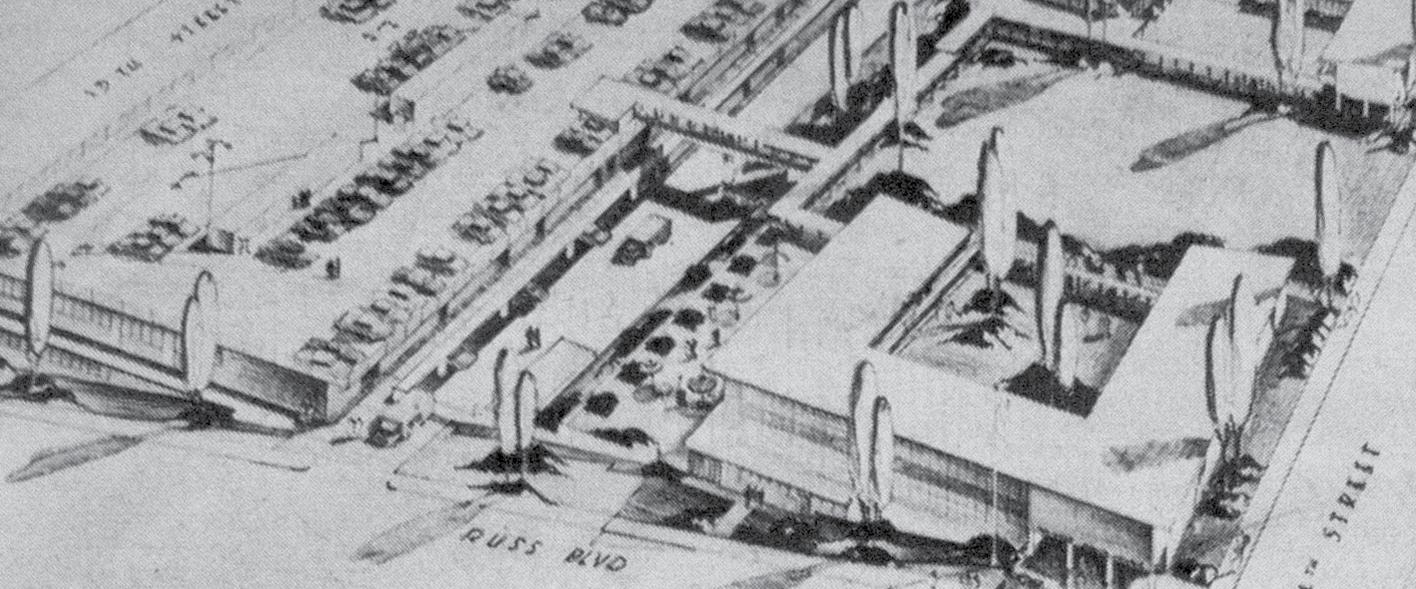
San Diego City College is a public, two-year community college administered by the San Diego Community College District. Among the centers of learning in downtown San Diego, the college comprises 60 acres and is one fifth of the downtown footprint. The college offers 250 majors and certificate programs and 1,500 classes each semester to more than 17,000 students. City College celebrated its 100th anniversary in 2014.
San Diego City College (also known informally as City College or City), is located at the heart of downtown San Diego at 1313 Park Boulevard. It is one of five colleges within the San Diego Community College District along with San Diego Mesa College, San Diego Miramar College and San Diego Continuing Education.
The City College campus consists of 40 buildings and is adjacent to San Diego High School. Courses are provided that lead to associate degrees and certificates, prepare students for transfer, and lead to licensure or certification in career fields.
Founded in 1914, San Diego City College was the first community college in San Diego (San Diego Junior College). Established when the Board of Education of the San Diego City Schools authorized post-secondary classes for the children of San Diego. Classes began that fall at San Diego High School, with four instructors and 35 students, establishing San Diego City College as the third community college in the state.
In 1921, City College relocated from the high school to City College’s facilities shared with San Diego State Teachers College now known as San Diego State University, where it remained for 25 years. In 1938, San Diego Vocational Junior College was established to provide training in technical-vocational skills to post high school students.
City College acquired land in 1953-54 for what is now the permanent home of the campus. During this time buildings A and T were constructed.
Increasing enrollment in the 1970s resulted in additional property added to the campus. This major expansion created buildings L, C, S, M, E, D and F.
The campus has received extensive expansion and renovations in the last 20 years starting with the opening of a 3,000-sq-ft Fitness Center in 1992. The Educational Technology Center opened in 2000 along with the Learning Resource Center (LRC) in 2002. The Harry West Gymnasium opened in 2005, the Academic Success Center in 2009, and Career Technology Center was inaugurated in late 2010. More recent expansions include the Mathematics and Social Science Building in 2013; and the Life Sciences and Physical Sciences as well as the Arts and Humanities & Business buildings in 2014.
San Diego City College has as its highest priority student learning and achievement. The college provides lower division and general education courses that lead to certificates, associate degrees or transfer to a four-year college or university; career technical education programs that meet specific industry needs, upgrade the employment skills of students and fulfill licensing requirements of the state of California as well as contribute to the economic development of our region; basic skills instruction to assist all students in meeting their educational goals; and essential student support services for all students.

San Diego City College is a multicultural institution committed to providing open access to all who can benefit from instruction and to meeting the diverse and ever-changing educational, cultural, and economic needs of the urban core and surrounding communities of San Diego. We are committed to the tradition of academic freedom and responsibility, to employee empowerment, and to maintaining a climate that promotes learning, understanding and respect for students, faculty, classified professionals, community, and the environment.
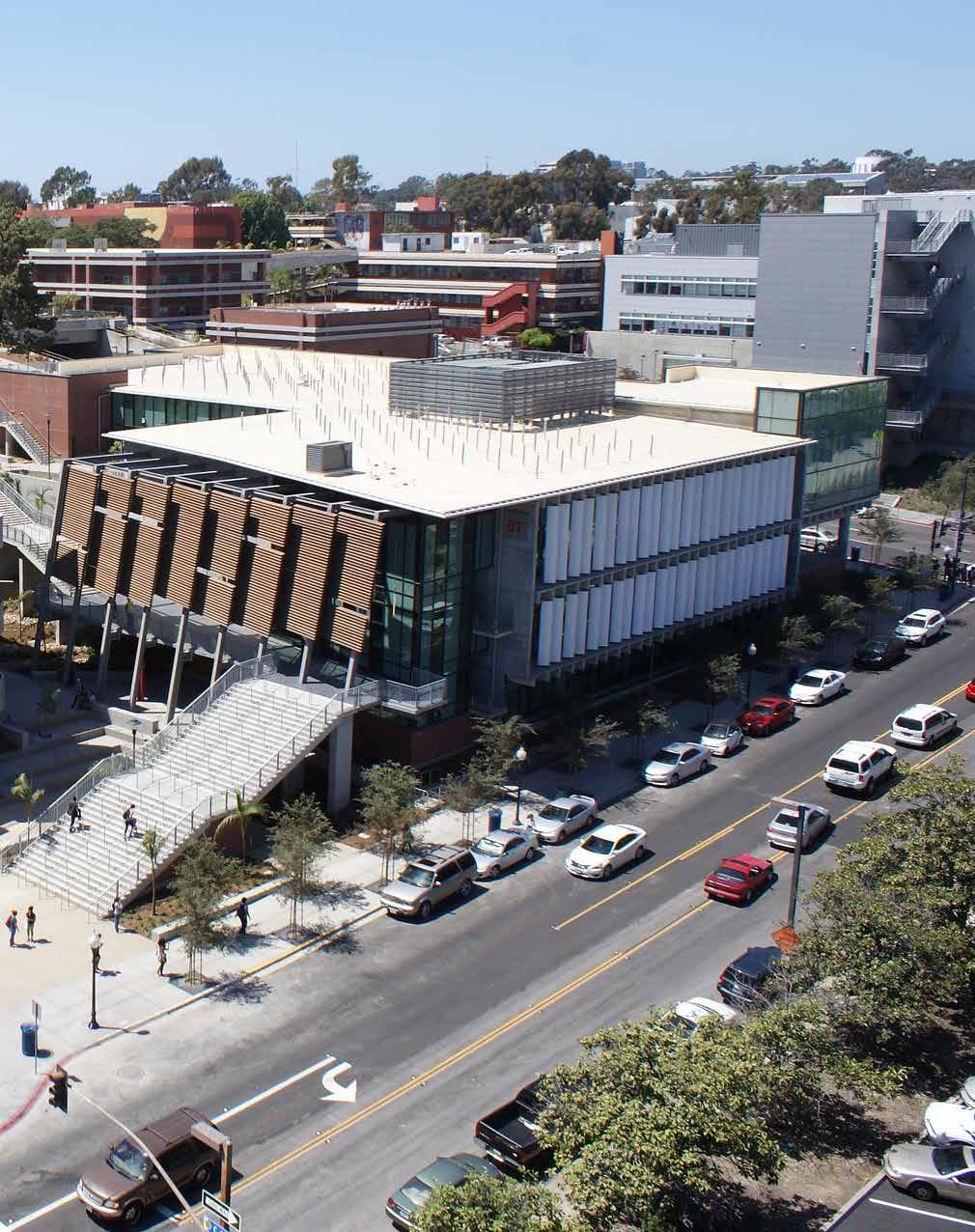
The following are core tenets of our value system:
• The development of informed, active individuals who will be engaged in the global community, lifelong learners, social justice advocates, and literate in information technology
• Institutional community involvement, community development and community service
• Equity, inclusiveness and diversity in all of its manifestations
• High quality instructional programs emphasizing creative and critical thinking
• Essential student support services, including co-curricular and cultural activities
• Environmental sustainability and a campus culture of conservation
• A continuous campus-wide cycle of assessment and program review with integrated planning and resource allocation

• Student Success - Support improved student learning, achievement of student learning outcomes, course completion, certificate and degree completion, transfer rates, and workforce competencies.
• Innovative Approaches - Provide state of-the-art general education, transfer, and career technical programs by utilizing current technologies, innovative teaching and learning approaches, and delivery systems, and academic and student support services which include essential student support services, including co-curricular and cultural activities.
• Equity, Inclusiveness, and Diversity - Strengthen and support an inclusive and diverse campus culture which enhances student, faculty, and staff success and closes equity gaps. City College promotes lifelong learning, social justice advocacy, and information technology literacy.
• Collaborative & Outreach Ventures - Develop collaborative and outreach ventures that enhance student learning within the college, district and community, public and private agencies, businesses, and industry — locally, nationally, and globally.
• Environmental Stewardship - Strengthen a measurable environmental stewardship effort that implements sustainable practices and educates the campus community.
• Institutional Accountability - Demonstrate accountability through the integrated process of assessment, program review, planning, resource allocation, accreditation, and ongoing evaluation.
Strategic Planning - Links campus planning to district planning efforts.
At San Diego City College, we commit to closing the opportunity gaps perpetuated by structural injustice in higher education. Closing the opportunity gap means dismantling the inequitable distribution of resources, opportunities, and policies to achieve parity in educational outcomes for historically marginalized student populations.

We commit to providing an inclusive and welcoming educational environment by recognizing and supporting the intersection of our community members’ multiple identities and roles through culturally-responsive pedagogy and equity-minded practices, behaviors and policies.
We are committed to sustaining a teaching, learning, and work culture that envisions and actively validates and uplifts our diverse community’s lived experiences to ensure a strength-based structural and cultural change at our institution.
San Diego City College acknowledges that we gather on unceded Kumeyaay land. We value Indigenous knowledge and cultural worldview. We commit to providing transformative educational experiences for all campus members and guests as we examine practices that perpetuate harm against Indigenous, Black, Brown, and other marginalized communities. We pledge to sustain a meaningful and respectful relationship with the Kumeyaay and other Indigenous communities as we honor this beautiful land together.
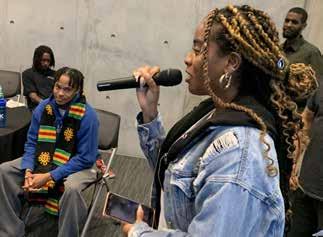
We commit to sustaining a teaching, learning, and working culture that envisions and actively validates and uplifts our diverse community’s lived experiences.


RICKY SHABAZZ, ED.D. President MATILDA CHAVEZ Vice President of Instruction
MARCIANO PEREZ, JR. Vice President of Student Services
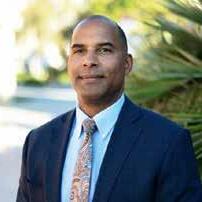

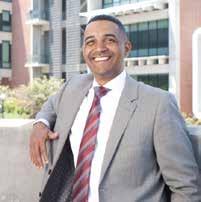
JOHN PARKER, DBA
Vice President of Administrative Services
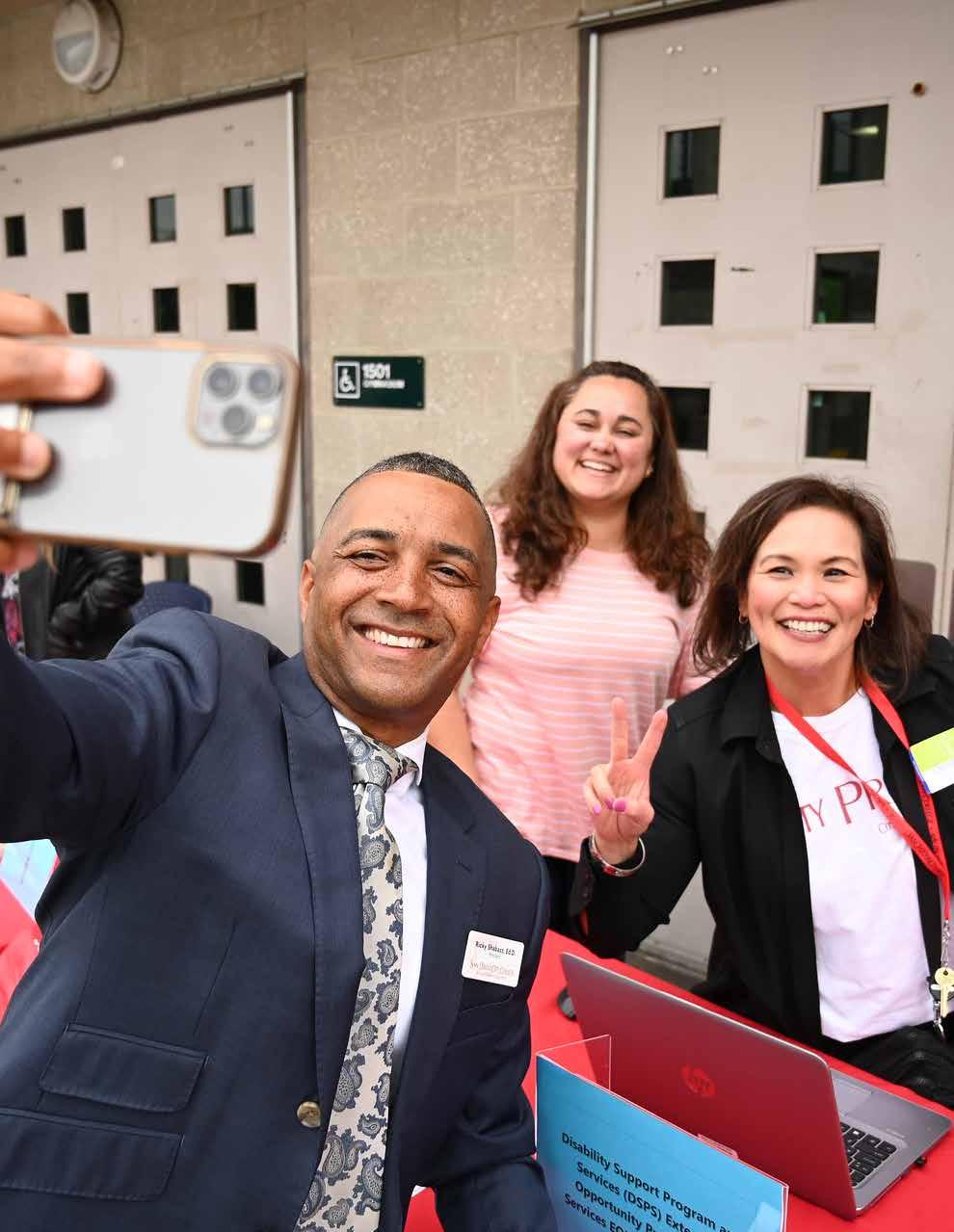
As a leader in social justice and academic excellence, I am proud to present San Diego City College’s 2022 Educational Plan. San Diego City College has a rich history of serving students in our region for more than 108 years. We celebrate our diverse and vibrant student body and our caring and dedicated classified professionals and faculty. Although we come from different places, we join together here at City College focused on one goal: student success.

Our Educational Plan serves as a blueprint that guides the college. The plan acts as a centerpiece of baseline data that informs users of new planning and strategies to move the college forward in innovative ways. It also serves as a guide for institutional and program development.
The development of the Educational Plan was coordinated by our Office of Institutional Effectiveness. We worked collaboratively with campus leaders and constituency groups in an engaging and intentional way. The plan incorporates the President’s Vision in alignment with an updated Strategic Plan focusing on five priorities in support of student success: Caring, Compassionate Connections; A Learning Culture Built on Social Justice and Equity; Professional and Talent Development; Philanthropy and Partnerships; and Effective Planning, Prioritization, and Process. The goals and strategies established in the plan assist the college in advancing student achievement, transforming infrastructure, and providing innovation opportunities for all.
I would like to thank everyone who put their time, effort, and love into our 2022 Educational Plan. It truly takes a village. We are excited for the future of our college and the future of our amazing students as we move into the future together.
San Diego City College is the leader in creating a learning culture that improves
justice, educational equity,
Shabazz, Ed.D.
academic
share the City College LOVE by creating caring and compassionate connections
We provide high-touch and high-quality pathways for students to complete
transfer and/or enter fulfilling careers
We promote talent and professional development in order to ensure our students see themselves in our curriculum and student services in order to support a diverse
learners
prioritize e orts to dismantle systems that negatively impact e orts
competency
our planning
processes
value partnerships and philanthropy that foster student success

completion
placement of students into high-demand careers and service-
The charts shown capture a snapshot of City College’s student population in fall 2021. Student profiles for fall terms are posted at https://www.sdcity.edu/about/history-facts/demographics.aspx. Over 13,000 students are enrolled in a given term; the annual unduplicated headcount is nearly 22,000. Over half of City students are taking fewer than six units in a term; 46% are Latinx; 5% participate in Disability Support Programs and Services; and 9% are enrolled in Extended Opportunity Programs and Services.
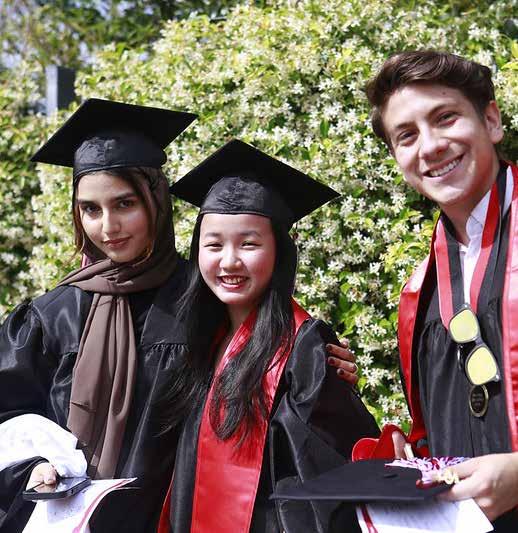
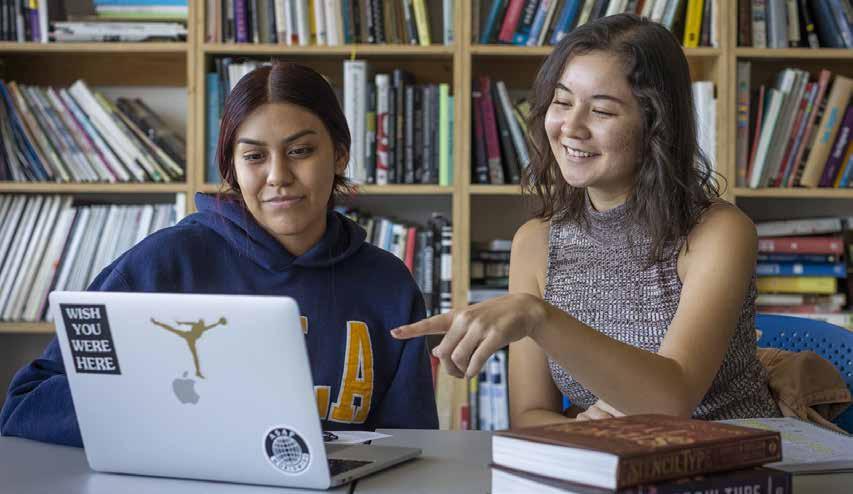

N = 1,343 Asian Black or African American

Human Resources San Diego City College
June 2021
Hispanic / Latinx
American Indian or Alaska Native
Native Hawaiian or Other Pacific Islander
White Two or More Races
Unknown/ NonRespondent Total
Total Employees: 135 10.1% 137 10.2% 312 23.2% 6 0.4% 1 0.1% 552 41.1% 53 3.9% 147 10.9% 1,343 Male: 45 8.5% 66 12.5% 119 22.5% 1 0.2% 0 0.0% 213 40.3% 21 4.0% 64 12.1% 529
Female: 90 11.1% 71 8.7% 193 23.7% 5 0.6% 1 0.1% 339 41.6% 32 3.9% 83 10.2% 814 Classified Staff: 18 15.1% 13 10.9% 35 29.4% 0 0.0% 1 0.8% 28 23.5% 6 5.0% 18 15.1% 119
Male: 7 18.9% 6 16.2% 8 21.6% 0 0.0% 0 0.0% 10 27.0% 1 2.7% 5 13.5% 37 Female: 11 13.4% 7 8.5% 27 32.9% 0 0.0% 1 1.2% 18 22.0% 5 6.1% 13 15.9% 82 Non Academic Hourly: 22 13.1% 20 11.9% 64 38.1% 0 0.0% 0 0.0% 43 25.6% 3 1.8% 16 9.5% 168 Male: 9 13.4% 7 10.4% 22 32.8% 0 0.0% 0 0.0% 21 31.3% 1 1.5% 7 10.4% 67 Female: 13 12.9% 13 12.9% 42 41.6% 0 0.0% 0 0.0% 22 21.8% 2 2.0% 9 8.9% 101 Contract Faculty: 17 10.2% 15 9.0% 28 16.8% 0 0.0% 0 0.0% 83 49.7% 8 4.8% 16 9.6% 167 Male: 5 7.8% 7 10.9% 14 21.9% 0 0.0% 0 0.0% 27 42.2% 4 6.3% 7 10.9% 64 Female: 12 11.7% 8 7.8% 14 13.6% 0 0.0% 0 0.0% 56 54.4% 4 3.9% 9 8.7% 103 Adjunct Faculty: 75 8.8% 83 9.7% 173 20.3% 5 0.6% 0 0.0% 390 45.7% 33 3.9% 94 11.0% 853 Male: 23 6.6% 44 12.7% 70 20.2% 0 0.0% 0 0.0% 152 43.8% 14 4.0% 44 12.7% 347 Female: 52 10.3% 39 7.7% 103 20.4% 5 1.0% 0 0.0% 238 47.0% 19 3.8% 50 9.9% 506 Management: 1 5.9% 5 29.4% 6 35.3% 0 0.0% 0 0.0% 3 17.6% 2 11.8% 0 0.0% 17 Male: 0 0.0% 2 28.6% 2
0 0.0% 0 0.0% 2 28.6% 1 14.3% 0 0.0% 7 Female: 1 10.0% 3 30.0% 4
0 0.0% 0 0.0% 1 10.0% 1 10.0% 0 0.0% 10 Supervisory Staff: 2 10.5% 1
6
1
0 0.0% 5 26.3% 1 5.3% 3 15.8% 19 Male: 1 14.3% 0 0.0%
1
3 25.0% 0 0.0% 0 0.0% 4 33.3% 1 8.3% 2 16.7% 12
0 0.0% 1 14.3% 0 0.0% 1 14.3% 7 Female: 1 8.3% 1

Note. The percentages in the table above are totaled by row.
City College employs over 1,300 individuals in a wide range of roles. The
the identities of City students, a priority in the new Strategic Plan.
Note: The percentages in the table above are totaled by row.
The priorities, goals, and strategies in the City College Strategic Plan were developed collaboratively through a series of campuswide conversations beginning in the fall of 2020. A timeline is presented in the Appendix.
All five strategic priorities are intended to guide college actions over the next seven years - there is no ranking or priority order. The institutional-level goals and strategies defined here will be operationalized across the college in documents such as the Enrollment Management Plan and Equity Plan, as well as in committee work plans and in Program Review and Area Plans for specific departments and programs.
The Strategic Plan was approved by constituency groups and College Council in May 2022.
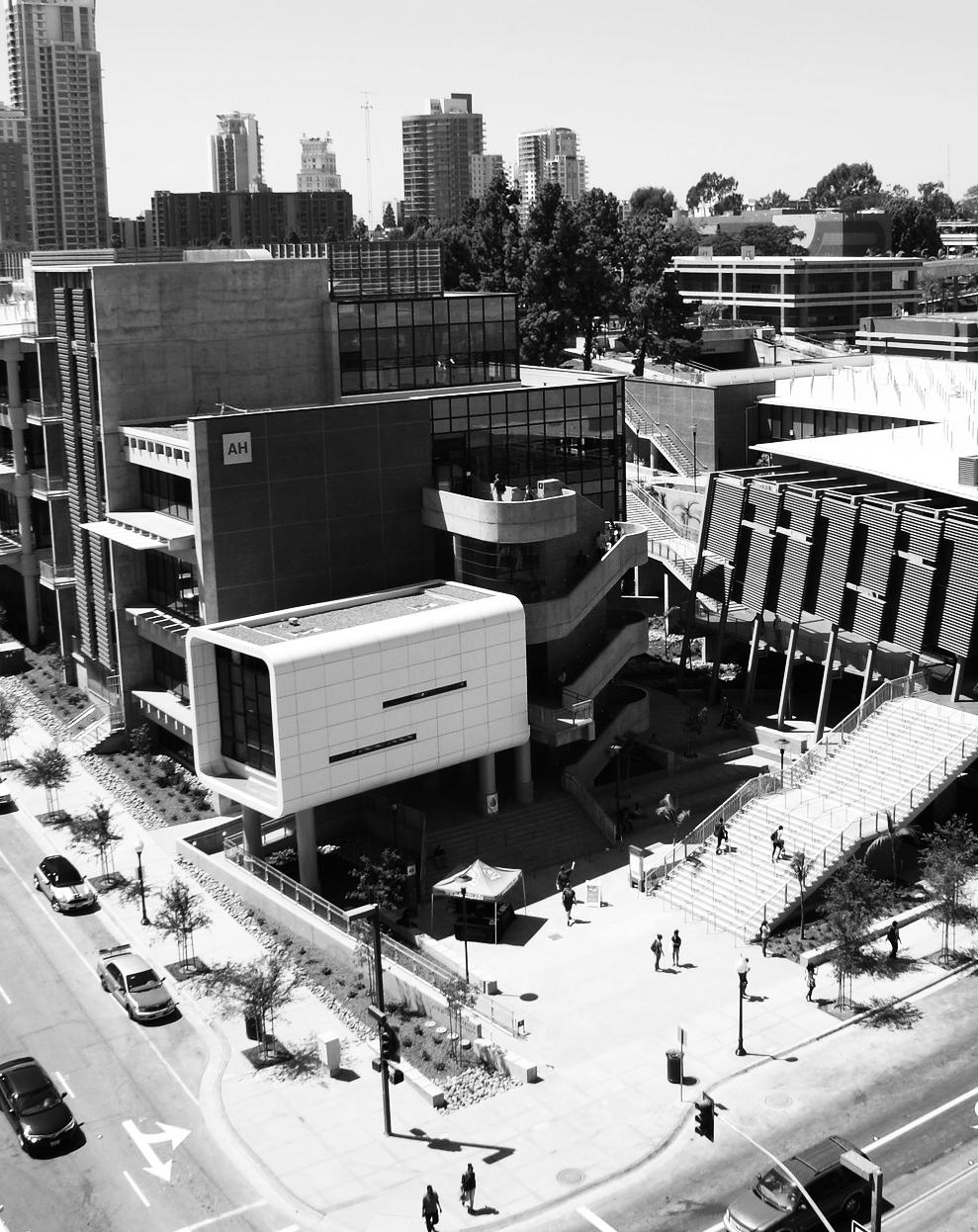
PRIORITY:ALEARNINGCULTUREBUILTONSOCIALJUSTICEANDEQUITY
SocialJusticeGoal1: City Collegewillexemplifyashared commitmenttoequityand socialjusticethatrecognizes andvaluesallmembersofthe collegecommunityandis reflectedincollegepractices.
SocialJusticeGoal2: Students andemployeesatCityCollege willplayatangiblerolein advancingsocialand environmentaljusticewithin thecommunityservedby thecollege.
SocialJusticeGoal3: All studentsandemployeeswillbe supportedtounderstand,adopt, andapplyequity-mindedand culturallyresponsivepractices, behaviors,andpolicies.
Supportdialogueandactionon equityandsocialjusticewithaccess toquantitativeandqualitativedata.
Developandimplementanupdated college-widestudentequityplan.
ThecollegewilldevelopaSocial JusticeandEquityCommitment, usingoursharedgovernance structure,toguideplanningand decision-makingin allareas.
Buildpartnershipswith communityorganizations workingonadvancingissuesof socialandenvironmental justice,equityandinclusion. Thesepartnershipssupportthe workoforganizationsand studentlearning anddevelopment.
Intentionallydevelopcurriculum thathighlightssocialjusticeand equityworkbeingdoneinthe communitythatconnectsCity Collegeandstudentsto thatwork.
IntentionallyexpandStudent Servicesthathighlightthesocial andenvironmentaljusticeand equityworkbeingdoneinthe communitythatconnectsCity Collegeandstudentsto thatwork.
Buildpartnershipswithcommunity organizationsworkingonadvancing issuesofsocialandenvironmental justice,equityandinclusion.These partnershipssupporttheworkof organizationsandstudentlearning anddevelopment.
Intentionallydevelopcurriculum thathighlightssocialjusticeand equityworkbeingdoneinthe communitythatconnectsCity Collegeandstudentsto thatwork.
EffectivenessGoal1: City Collegewillenhanceeffective planninganddecision-making throughclearlydefined processesthatsupport transparencyand broadparticipation.
EffectivenessGoal2: City Collegewillcreateandadopt flexibleandproactive processesforrespondingto large-scaleeffortstoinvolve thewholecollegewith integratedplanning.
EffectivenessGoal3: City Collegewillprioritize implementationofpracticesthat supportequitableoutcomes acrossracial/ethnicgroupsand otherdisproportionately impactedstudentpopulations.
Breaksilosandworkacross
WorkforcePartnership.
City College uses a range of quantitative and qualitative sources of data to inform planning, continuously evaluate effectiveness and improvement, and identify resources and needs.


The college has experienced gradual declines in enrollment since 2016/17. Part-time attendance is also rising, with over half of the student body taking fewer than six units each semester. High part-time enrollment means that more individuals must be enrolled, advised, and supported with services to reach the college’s targets for full-time equivalent students (FTES). During the height of the COVID-19 pandemic in 2020/21, more students were taking courses across multiple colleges within SDCCD, increasing the headcount but decreasing FTES.
The data presented here were reviewed and considered throughout the development of the Strategic Plan and are regularly discussed in governance groups and institutional planning processes. Most of these sources are updated annually; the most recent data available are included.
City College Headcount Prior Year % Change City College FTES Prior Year % Change
2016/17 26,731 10,525
2017/18 25,638 -4.1% 10,123 -3.8%
2018/19 24,348 -5.0% 9,614 -5.0% 2019/20 23,329 -4.2% 9,175 -4.6%
2020/21 24,516 5.1% 7,541 -17.8% 2021/22 21,843 -10.9% 6,574 -12.8%
Headcount is the number of individual students. Each student is counted once regardless of the number of courses in which the student enrolls. FTES is a student workload measure equal to 30 credit hours of enrollment, which is equal to 525 contact hours in an academic year. The values in these tables include both resident and non-resident FTES.
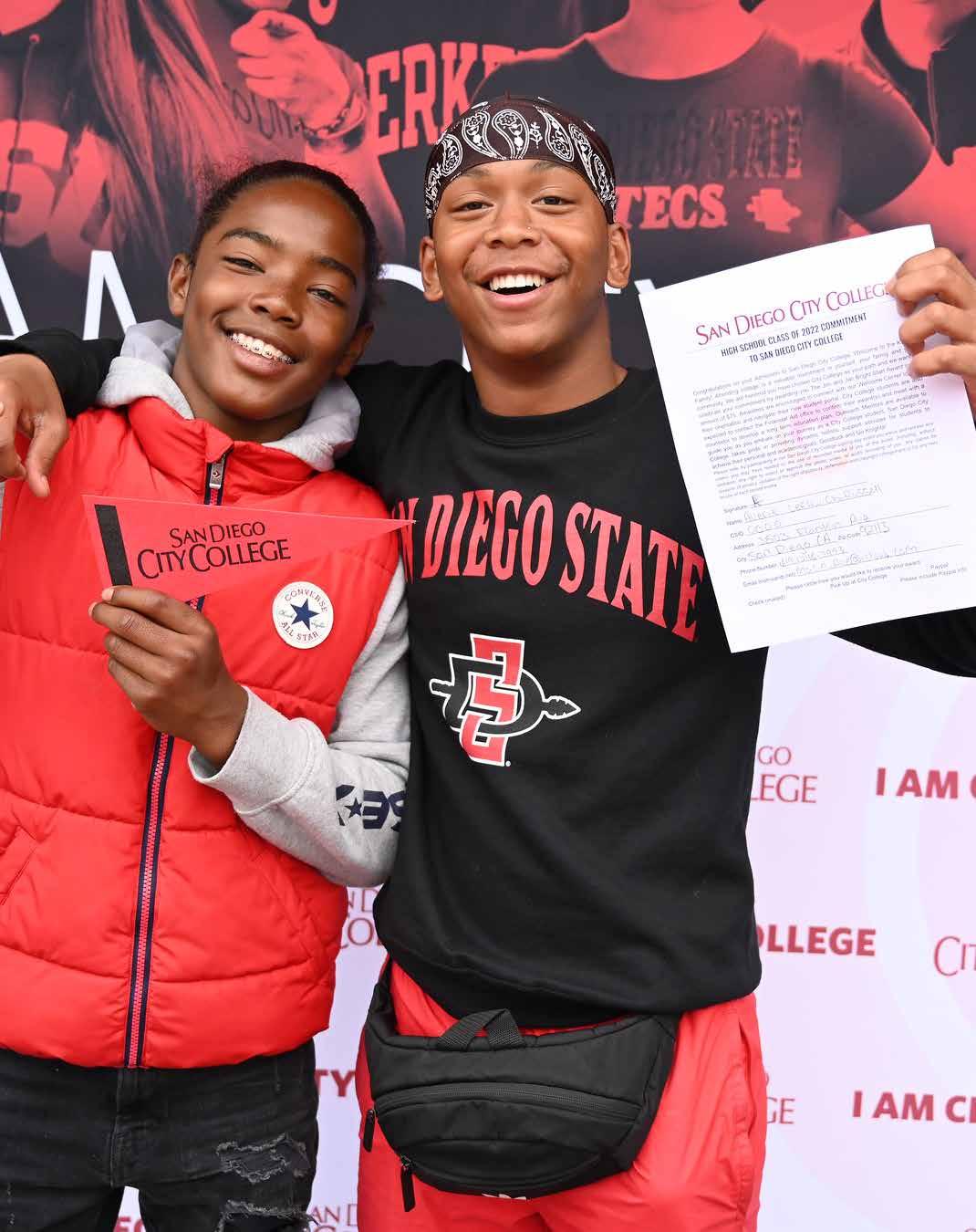
Prior to the COVID-19 pandemic and health restrictions that prohibited on-campus activities, the majority of students enrolled in traditional on-campus face-to-face courses. The percentage of students enrolled in on-cam pus courses steadily decreased between 2016/17 and 2019/20 while the percentage of students enrolled online (or both on-campus and online) gradually increased from 20% in 2016/17 to 29% in 2019/20. In 2020/21 and 2020/22, over 90% of City College enrollments were in online courses.

Enrollment is the number of registrations. When a student enrolls in multiple courses, each enrollment (or registration) is counted.
SD City
City College monitors and assesses student progress and success at all levels. Data are also disaggregated for subpopulations of students to support ongoing analysis of equity in student outcomes. Course success and program outcomes are central to the college’s annual Program Review process. At the institutional level, the college’s Institution Set Standards provide a framework for monitoring overall student achievement.
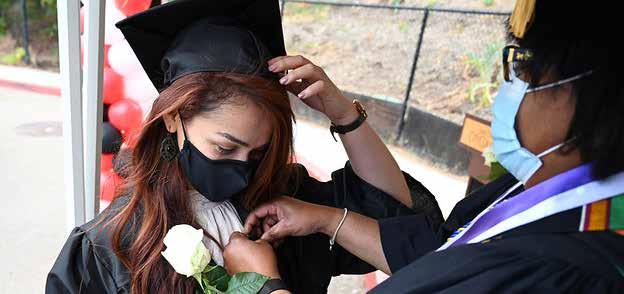
Institution Set Standards are updated annually and reviewed by the Institutional Research and Effectiveness Committee. Recommendations for setting performance standards are discussed in City Planning (formerly MPAROC) and brought forward to College Council.
(A, B, C, or P) out of the total course enrollments. Future course completion rates are given Institution
Standard Acceptable Ranges and Aspirational Goals. The aspirational goal that was set through committee discussion informed by the 2010/11 2014/15 data was to increase the course completion rate to 72% by 2021/22. This past academic year, the course completion rate has fallen above the acceptable range. An academic year includes Summer, Fall, & Spring terms (e.g., 2020/21 = Summer 20, Fall 20, & Spring 21).
SDCC Institution Set Standards: 2021/22
Institution Set Standard: Annual Retention (formerly persistence)

Acceptable Range Success Rate Evaluation
Low High 2021/22 68.9% 70.0% 2020/21 68.5% 69.5% 70.6% Above range 2019/20 68.6% 69.5%
Below range 2018/19 68.2% 68.8%
Above range 2017/18 67.7% 68.3%
Actions for Achieving Aspirational Goal:
Successful course completion is the percentage of course enrollments resulting in a successful grade (A, B, C, or P) out of the total course enrollments. . The aspirational goal of 72% successful course completion was set through committee discussion informed by the 2010/11- 2014/15 data. The impact of the COVID-19 pandemic is visible in the 2019-2020 data, but course success rates returned to previous levels in 2020-2021.
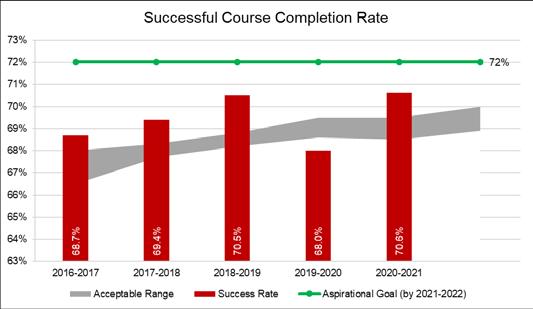
Above range 2016/17 66.5% 68.0%
Math and English completion
Learning communities
Professional development
Program review
Annual retention refers to the percentage of first time students enrolled at SDCC in a fall term, who enroll in the subsequent fall term within SDCCD. Future annual retention rates are given Institution Set Standard Acceptable Ranges and Aspirational Goals. The aspirational goal that was set through com mittee discussion informed by Fall 2010 Fall 2014 cohort data was to increase annual retention to 59% by 2020/21. This past academic year, the annual retention rate has fallen below the acceptable range.
Above range
Range: 5 year average of rates ± 0.5 standard deviation
Student Equity and Achievement funded initiatives
Tutoring & supplemental instruction
SDCC Office of Institutional Research | 2
Acceptable Range Annual Retention Evaluation
Low High Fall 21 53.8% 57.3%
Fall 20 54.5% 58.0% 53.8% Below range Fall 19 55.0% 58.2% 53.0% Below range Fall 18 54.5% 55.8% 61.8% Above range Fall 17 54.6% 55.9% 54.6% In range Fall 16 54.5% 55.9% 54.5% In range
Range: 5 year average of rates ± 0.5 standard deviation
Actions for Achieving Aspirational Goal:
Math and English completion
Enrollment management
First Year Services
Annual retention refers to the percentage of first-time students enrolled at City College in a fall term, who continue to be enrolled within SDCCD in the subsequent fall term. After a significant increase in the retention rate for the fall 2018 entering cohort, those gains reversed during the COVID-19 pandemic. City college also saw an increase in the number of students attending part-time, which also may have affected retention. This is a current area of focus for enrollment management planning.
Learning communities
Program review
Student Equity and Achievement funded initiatives
Tutoring & supplemental instruction
Set Standard:
Completion
Degree completion is t he number of students who earned an AA/AS degree in a given year. Future
SDCC Institution Set Standards: 2021/22
Institution Set Standard: Certificate Completion
Certificate completion is the number of students who earned a certificate in a given year. Future certificate completion Institution Set Standard Acceptable Ranges and Aspirational Goals were set through committee discussion informed by 2010/11 2014/15 data. The aspirational goal is to increase the number of s tudents who earn
certificate
571 by 2021/22 For
two academic years, the number of students who earned

An academic year includes Summer, Fall,
Spring
SDCC Office of Institutional Research | 4
metric reflects the number of Certificate of Achievement
for Achieving Aspirational Goal:
given in an academic year (summer, fall, and spring terms). Similar to other metrics, certificate awards were also reduced during the COVID-19 pandemic. City Institutional Research is also collaborating with Strong Workforce and CTE programs to develop better systems for tracking short-term Certificates of Performance.

20 09/10 2013/14
For
SDCC Institution Set Standards: 2021/22
Standard: Licensure/Certification Exam Results: Nursing Licensure/certification
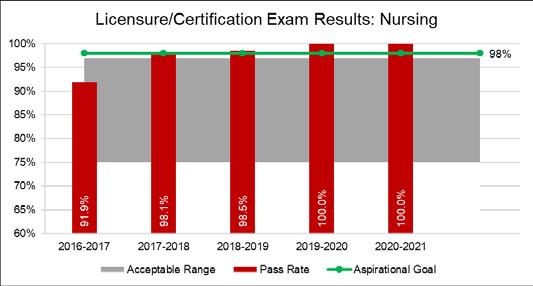
are
percent of students who passed each licensure/ certification
Actions for Achieving Aspirational Goal:
results are given Institution Set Standard Acceptable Ranges and

the licensure/certification exam pass rate to above 98%
achieved in
exam pass rates
and 2019/20
Transfer volume tracks the number of students who transfer to a 4-year institution in a given academic year. A student must have completed 12 or more transferable units within six years and have been actively enrolled within two years prior to transferring. For the past four academic years, transfer volume has surpassed the aspirational goal. City College’s Nursing Education Program graduates have outstanding pass rates on the NCLEX licensure exam. in both the 2019-20 and 2020-21 years, 100% of graduates successfully passed.
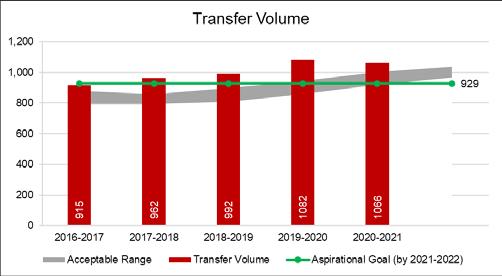
Acceptable Range Pass Rate Evaluation
75.0% 97.0% 100% Above range 2019/20 75.0% 97.0% 100% Above range 2018/19 75.0% 97.0% 98.5% Above range 2017/18 75.0% 97.0% 98.1% Above range 2016/17 75.0% 97.0% 91.9% In range
Annual advisory board meetings
Anonymous course surveys
Bi monthly faculty meetings reviewing curriculum, SLOs, & policies/procedures for admission, retention, & attrition
End of course reports
Meetings with Biology department to
EQUITY goals are identified in the college’s Equity Plan, currently being updated. Disaggregated course and program data have long been provided to support Program Review. Beginning with the Fall 2022 cycle, the Program Review process will formally include a response to the college’s newly adopted Social Justice Commitment.
Institutional planning considers factors beyond the college that impact students. Understanding these circumstances guides City College in providing the resources that make a difference in students’ enrollment, retention, and success.

Institutional planning considers factors beyond the college that impact students.
City College students are more likely to experience basic needs insecurity — uncertainty about food or housing, or homelessness — than are students at other SDCCD colleges or two-year colleges nationally.
City College has partnered with Feeding San Diego and the San Diego Food Bank to have free food and produce distributions on campus twice per month. Hunger Action Days have been held consistently since 2018, and were converted to a drive-through model to accommodate health restrictions during the pandemic. Welcome Home City is a grant-funded program providing support, resources, and case management for students who are experiencing homelessness or housing insecurity to meet basic needs and help secure permanent housing.


Data Source: 2020 #RealCollege Survey, from 2,963 San Diego City College respondents. “Any BNI” includes students who experienced food insecurity, housing insecurity, or homelessness within the year prior to the survey.
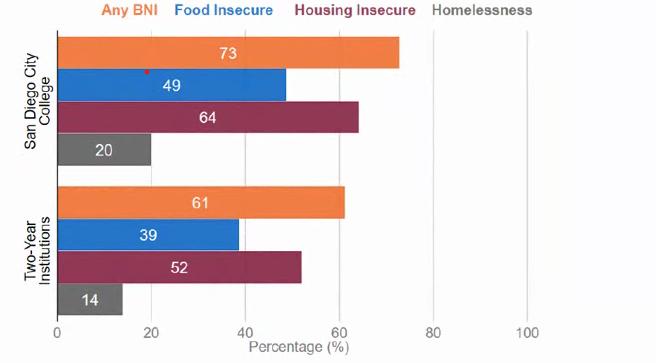
San Diego’s economy has experienced significant shifts due to the COVID-19 pandemic.


The pandemic has disproportionately affected persons of color in San Diego County. The majority of residents who report that they or someone in their household experienced negative economic impacts due to the pandemic are more likely to be Latinx or Black.


Data Source: SANDAG, San Diego Economy COVID-19 Impacts: A Year in Review, March 2021

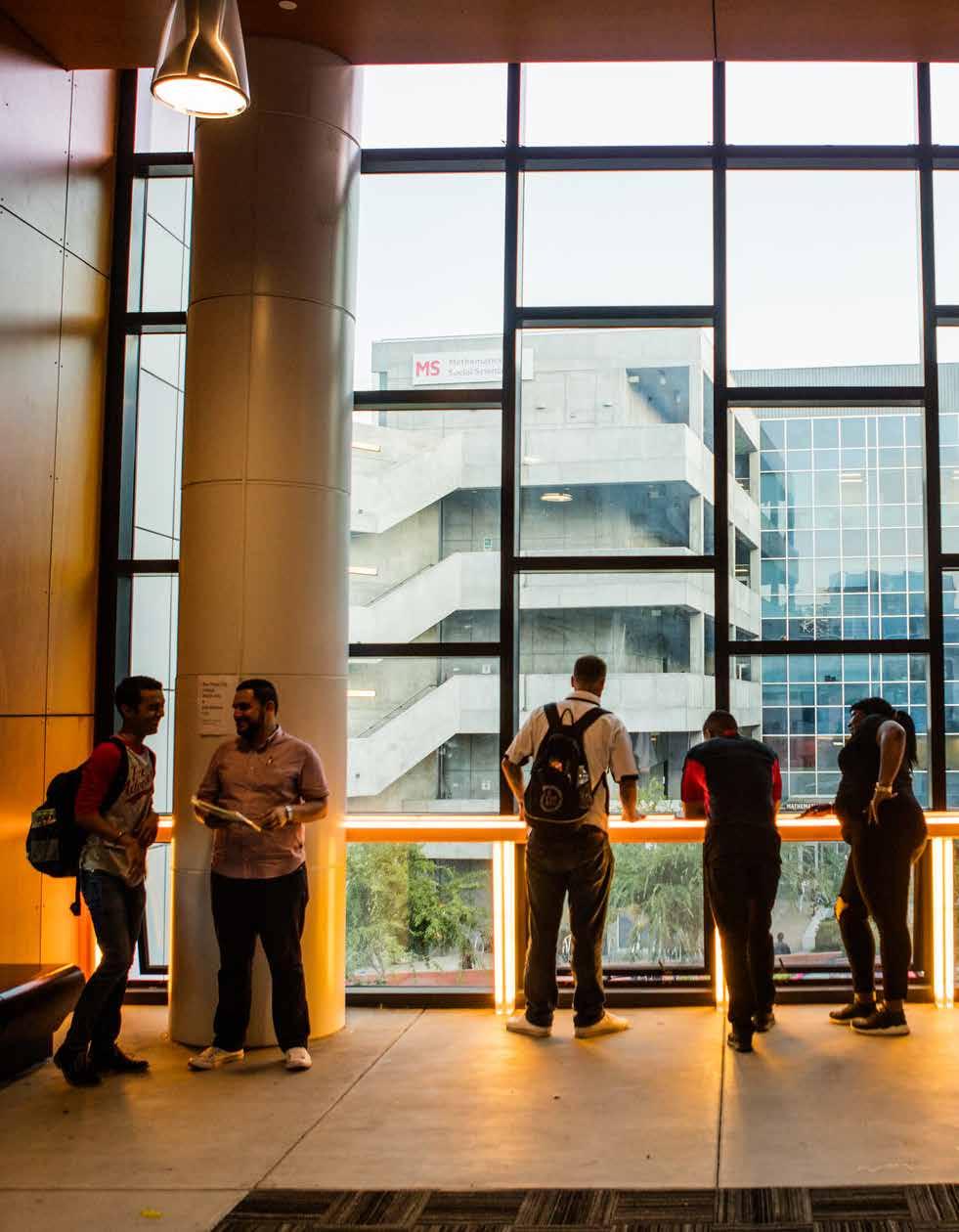
Accreditation Expectations: Assuring Academic Quality and Institutional Effectiveness (Std. I. B.), Institutional Integrity (Std. I. C), Student Learning and Support (Std. II)
New Plans (Annual - Sept)
Mid-Year Update (Annual - Dec)
Program Plans and Updates (Annual - Nov)
Resource Requests (Annual - Nov)
Comprehensive Plan (Every 3 years - Nov)
Program Outcomes Assessment
SLO Assessment Course, Program Institutional
Data Dashboards: Program Review, Enrollment, Project Based
Event Plans & Evaluations
Metrics
Administrators’ Annual Goals
(Annual - March)
Year-End Report (May)
COURSE SLO ASSESSMENT
Program Area (Dean) Division (VP) College
City College uses its governance structure of committees and councils to ensure that constituency groups — students, faculty, classified professionals, supervisors, managers and administrators — have a voice in planning and decision-making. The college’s institutional planning processes combines open forums and twice-yearly Planning Summits with review and approval by governance and constituency groups, culminating at College Council, the highest participatory governance body within the college.
City College aligns with Accrediting Commission for Community and Junior Colleges (ACCJC) accreditation standards through published planning cycles and evaluation of effectiveness. Institutional data and results of assessment processes are used to make improvements and inform future planning. By regularly and actively engaging in planning, the college builds consensus, connects efforts across different areas of the institution, and enables proactive, rather than reactive, change.
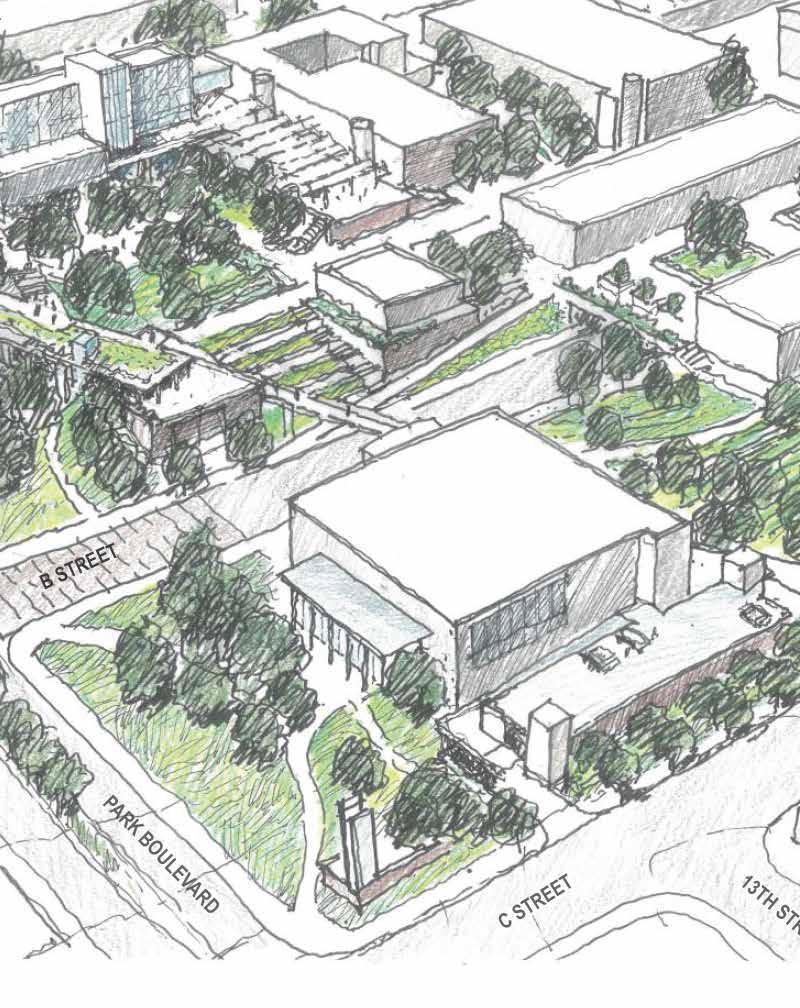
Implementation of City College’s Educational Plan will be carried out within the college’s governance structure and across administrative areas. As the highest level of participatory governance, College Council will have oversight of the Educational Plan as a whole. Governance bodies that report to College Council coordinate and monitor implementation for specific components, such as the Strategic Plan (City Planning) and the Enrollment Management Plan (City Student Journey). Through Program Review, all instructional, student services, and administrative areas of the college follow through on the Educational Plan by linking program outcomes and improvement goals to institutional priorities. Results are reported annually in Program Review and in Area Plans which are reviewed by the Vice Presidents, Deans, and direct reports. Adoption of the Nuventive software platform in fall 2022 will facilitate sharing of results by adding more robust reporting tools.
San Diego City College has served students for more than 108 years as one of the fastest-growing community colleges in the nation. City College has as its highest priority student learning and success. The college is committed to providing an array of comprehensive programs and services that support the recruitment, retention, transition, and academic success of students so that they may achieve their academic, career, and life goals. City College’s academic priority is directly coupled with its commitment to address the future needs of campus life and infrastructure. The purpose of the Facilities Plan (FP) is to facilitate the progressive improvement and advancement of the college in order to meet the demands of its rapidly growing community. The FP adapts City College objectives and ambitions of the campus and establishes priorities for future development that plans for managed student growth.
The Facilities Plan documents strategic adjustments to academic direction and updates visions for the development of City College, a vital component of San Diego and downtown’s rapidly transforming culture. Insight from current stakeholders of City College, the San Diego Community College District, local development groups, and residents of San Diego directly formed the planning priorities and scope of the FP. These entities identified capacities for improvements through participation in open forums and committee meetings that will in turn support the evolving future of City College students and staff.

The purpose of the Facilities Plan is to facilitate the progressive improvement and advancement of the college in order to meet the demands of its rapidly growing community.
Although enrollment rates have declined in recent years, the college service area is growing annually, consistent with both the growth rate of California and the nation.
These statistics act as evidence-based directives for the Facilities Plan:
Accommodate the diverse array of students.
Study possible implementations of student housing and reorganized programs to support students of all backgrounds and financial or housing insecurities.
Review parking and transit opportunities to ensure physical access to education for 16,000 students to 25,000 students on campus moving forward.

The physical attributes and constraints of the existing campus materialize as challenges for City College to confront. The Facilities Plan reviews the surrounding context, existing challenges of site topography, limited vehicular access, and constrained campus circulation to develop a series of opportunities and challenges into penchants for future development. The Facilities Plan document identifies the repair, remodel or replacement of existing facilities that do not meet educational or infrastructural necessity. The plan generates justifiable capital programs that identify preferred land use, potential building addition sites including parking structures and dorm locations, repurposing and modernization of existing buildings, athletic program improvements, identification of potential accessibility barriers, infrastructure opportunity plans, and maximum build-out capacity massings in accordance with department programmatic needs and future demographics of City College. It is possible to implement the plan in a phased manner where students, faculty, and staff may engage in campus events in a safe and comfortable manner with minimal disturbances from redevelopment and minor disruption to the surrounding community. The Facilities Plan shall continue to develop and update alongside challenges as they may arise and evolve as needs change over time, as new opportunities emerge from the surrounding community, or as campus or user-driven priorities are reconsidered.

The result is the 2022 Facilities Plan, a document that describes the current status of the campus, summarizes its needs and goals, and outlines the common vision and purpose for the future of San Diego City College.
To view complete report visit: https://acrobat.adobe.com/link/track?uri=urn:aaid:scds:US:e73bf698-abd8-47d6-b7c8-6ff65b28c867
As part of its Educational Plan, San Diego City College developed and implemented a comprehensive enrollment management plan. The purpose of this plan is to create a responsive, flexible, educationally sound and researchinformed approach to enrollment management.

This enrollment management plan is part of an overall set of college-wide enrollment management strategies that are intended to provide an overview of college resources and projects that work to increase enrollment, college access and equity, matriculation, student success and retention on campus. This plan is necessary to aid the college in addressing both increasing and decreasing enrollment, as California’s economic climate continually fluctuates.
In 2017, the college formed an Enrollment Management Committee (EMC) with workgroups for marketing and outreach, enrollment, and retention. Committee members include key stakeholders from across campus. In 2021-22, as part of the college’s governance review and committee realignment project, the EMC merged with the Student Success Initiatives Council to form the City Student Journey Committee. City Student Journey is committed to ensuring student success, college access and the integration of resource access to programs, departments, and individuals to support innovative approaches to enrollment management and student success at all phases of the educational process: outreach, enrollment, retention, completion, and transfer.
The Enrollment Management Plan is intended to ensure the following:
1. The achievement of enrollment targets in order to obtain maximum resources available to City College.

2. Maintain student access and pathways consistent with educational quality.
3. Offer a well-balanced and varied schedule responsive to the needs of our students and community.
4. Maintain a comprehensive educational program that is responsive to the needs of our students and community.
The 2019-2022 Enrollment Management Plan has three areas of focus, with specific strategies for each:
1. Innovative and Flexible Scheduling Practices
• Online Course Offerings
• Targeted Annual Scheduling and Weekend and Evening (Night@City) Courses
• Scheduling for Working Adults During Weekends and Evenings
• Late Start Courses and Varied Options for the Length of Time a Class Runs
2. Collaboration with the Community through Marketing and Outreach
•
•
•
Participation in Dual/Concurrent Enrollment/AB288
Education and Other Off-Site Location Partnership Expansion
Among Colleagues within our School
• City College Marketing Plan
•
College Outreach Plan
3. Models of Practice for
•
•
•
•
•
•
•
and
for students on Academic Probation or Academic
all Roles and all Areas of the College
Scheduling
San Diego City College develops a formal Equity Plan every three years in alignment with guidance from the California Community College Chancellor’s Office (CCCCO). The 2019-2022 plan was developed by the Student Success Equity Taskforce consisting of administrators, faculty, classified professionals and students that coordinates and evaluates equity-focused programs. This body reported to the Student Success Initiatives Council (SSIC), which was created to facilitate and coordinate integration of categorical and campusbased initiatives including those, focused on equity related interventions.
Activities in the 2019-2022 plan supported progress of disproportionately impacted student groups in four success metrics: transfer to a four-year institution,
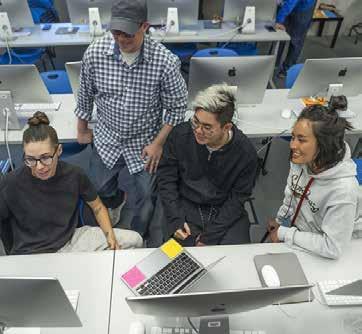
in the 2019-2022
of
attaining the Vision Goal Completion metric, completing transfer English and math in the first year of enrollment, and retention from fall to fall at the same college. Specific strategies included professional development for faculty and staff; peer mentoring; services that support students’ mental wellbeing and career, transfer, and academic success; counseling services to all first time to college students through general counseling and first year programs such as Promise, Umoja, Puente, City Scholars; instructional design and delivery including accelerated math, English Language Acquisition courses (ELAC), and concurrent support courses; targeted student engagement programming including City Women Rock leadership Conference, Hermanos Unidos-Brothers United Conference for men of color; and other interventions including university field trips to promote transfer and expose students to four-year institutions.
The 2022-2025 plan is in development. The planning process has been adjusted to accommodate a new plan structure and updates to the data and methodology identifying disproportionately impacted student groups provided by the CCCCO. In alignment with changes in City’s participatory governance structure, development of the plan is being led by the City Student Journey Committee, which has merged the SSIC and Enrollment Management groups into one entity providing oversight for all aspects of the student journey from initial contact to successful completion. Workgroups drawn from the Student Journey and IDEAAS (Inclusion, Diversity, Equity, Anti-racism, Accessibility, and Sustainability) committees and their reporting subgroups examined disproportionate impact across five success metrics: successful enrollment, completion of transfer-level math and English, retention from first primary term to secondary term, completion, and transfer.
The new plan structure calls for identification of the following elements for each metric:
• Population experiencing the most significant disproportionate impact
• Target outcomes for 2022-25
• Structural evaluation of current policies, processes, practices, and culture impacting equitable outcomes, and what changes would be necessary to make these structures more equity-minded
• Intended recipients of the change, with action steps

• Identification of support needed from the CCCCO
The draft plan will be reviewed and approved by college constituency and governance groups before final submission in November 2022.
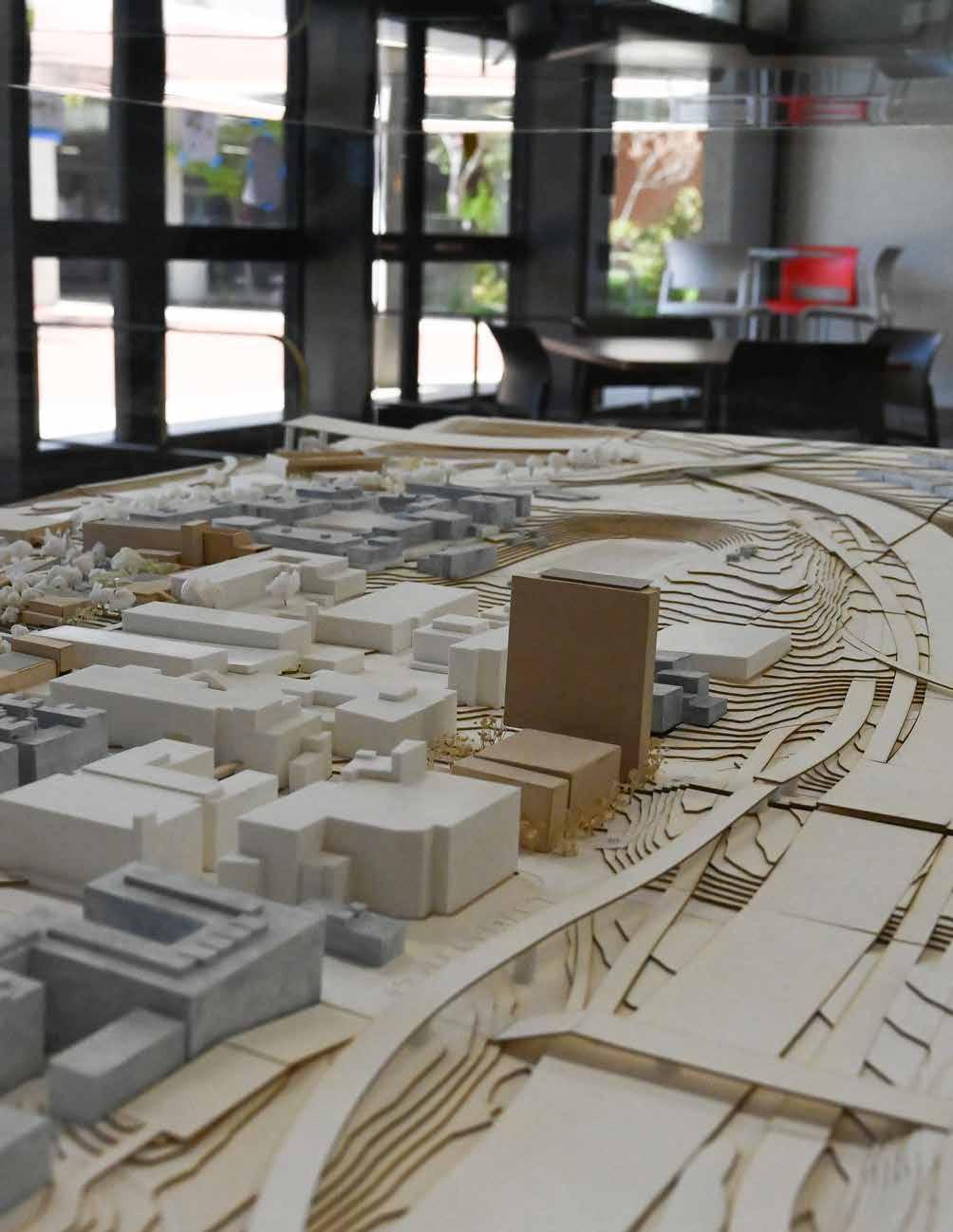
The initial timeline for producing a new Strategic Plan and updating the Educational Plan was disrupted by the COVID-19 pandemic. In-person events that were scheduled for April and May 2020 were canceled and restructured as virtual events beginning in fall 2020. Below are some key milestones in the college-wide planning process. In addition to these open events, regular updates were presented to the City Planning Council (formerly MPAROC) and College Council.

September4,2020: Initial PlanningForum.Reflection onuniqueassetsofCity College;whatsuccess lookslikeforthe institution;buildingan ethicofloveandcaring; andidentifyingneedsand wantsthattheStrategic Planshouldaddress.
September4,2020: Initial PlanningForum.Reflection onuniqueassetsofCity College;whatsuccess lookslikeforthe institution;buildingan ethicofloveandcaring; andidentifyingneedsand wantsthattheStrategic Planshouldaddress.
November6,2020: CommunityPartners Forum.Representatives fromcommunity,K-12,and employerorganizations wereinvitedtoshareinput onthedirectionofcollege programs,services,and facilities.
November6,2020: CommunityPartners Forum.Representatives fromcommunity,K-12,and employerorganizations wereinvitedtoshareinput onthedirectionofcollege programs,services,and facilities.
Spring2021: Workgroupand committeediscussions ofinputreceived.
Spring2021: Workgroupand committeediscussions ofinputreceived.
September4,2020
September4,2020
September17,2021: Fall PlanningSummit.
September17,2021: Fall PlanningSummit.
Preliminaryidentification ofstrategicpriorities;begin discussionofgoalsand strategies.
Preliminaryidentification ofstrategicpriorities;begin discussionofgoalsand strategies.
Spring2021
Spring2021
June2021
June2021
November6,2020
November6,2020
February11,2022: Spring PlanningSummit.
February11,2022: Spring PlanningSummit. Developmentofgoalsand strategiesforfivestrategic priorityareas.
Developmentofgoalsand strategiesforfivestrategic priorityareas.
May7,2021
May7,2021
April19,2022: Student VirtualForum.
April19,2022: Student VirtualForum.
August2021
August2021
May7,2021: Equity Summit.DefiningCity’s commitmenttosocial justiceandequity.
May7,2021: Equity Summit.DefiningCity’s commitmenttosocial justiceandequity.
June2021: Executive CabinetRetreat.
June2021: Executive CabinetRetreat.
August2021: Fall Convocation.President’s Vision.
August2021: Fall Convocation.President’s Vision.
September17,2021
September17,2021
April19,2022
April19,2022
October2022
October2022
August2021
February11,2022
February11,2022
May2022: Reviewand approvalbyAcademic Senate,ClassifiedSenate, SPAA,ASG,andCollege Council.
May2022: Reviewand approvalbyAcademic Senate,ClassifiedSenate, SPAA,ASG,andCollege Council.
October2022: Board Presentation.
October2022: Board Presentation.
Ricky Shabazz, President
Mona Alsoraimi, Past President, Academic Senate
Matilda Chavez, Vice President, Instruction
Robbi Ewell, Chair, Institutional Technology Council
Cesar Gumapas, Information Officer
Josolyn Hill, Supervisory Representative
Soon-Ah Fadness, President, Chairs’ Cabinet
Susan Murray, Dean, Institutional Effectiveness and Chair, City Planning
Masahiro Omae, Administrative Representative
Diego Bethea, President, Associated Students
Government (ASG)
John Parker, Vice President, Administrative Services
Marciano Perez, Jr., Vice President, Student Services
Sean Ryan, President, Classified Senate
María-José Zeledón-Pérez, President, Academic Senate
Christopher Acedo, Radio, TV and Film
Paul Alexander, English/Past President, Academic Senate
Sooh-Ah Fadness, Philosophy
Georgina Garcia, Counseling
Alpa Gautam, Biology
Christopher Godbout, Mathematics
Abel Macias, Counseling
Leann Mulholland, Librarian
Nadia Mandilawi, English/Chair of Chairs
Anna Rogers, English
Cynthia Short, Independent Learning Center
Terry Wilson, Dance
María-José Zeledón-Pérez, Communications/President, Academic Senate
John Parker, Vice President, Administrative Services
Marciano Perez, Vice President, Student Services
Tillie Chavez, Vice President, Instruction
Susan Murray, Dean of Institutional Effectiveness
Aaron Detty, Dean of Health, Exercise Science & Athletics
Genevieve Esguerra, Dean of Outreach and Community Relations
Masahiro Omae, Dean of Behavioral and Social Sciences, Consumer & Family Studies
Robbi Ewell,, Dean of Libraries and Learning Technology
Nesha Savage, Dean of Student Development
Kate Woodward, Math Center
Brittney Carroll, Research & Planning Analyst
Cesar Gumapas, Information Officer
John Parker, Vice President, Administrative Services
Roxann Solis, Supervisor, Business Services
Matilda Chavez, Vice President, Instruction
Aaron Detty, Dean of Health, Exercise Science, & Athletics
Joan L. Taylor, Production Services Assistant, Digital Print & Mailroom
Terri Hughes-Oelrich, Faculty, Fine Art
Darren Walters, Faculty, Counseling
Jay Purnell, Supervisor, Facilities
Susan Murray, Dean of Institutional Effectiveness
Jeanie Tyler, Dean of Arts, Humanities, Communications, & Telecommunications
Terry Wilson, Faculty, Dance
Roesling Nakamura Terada Architects (RNT)
Rob Wellington Quigley Architects (RWQA)
Equity Commitment Steering Committee
Professional Development Coordinators
Student Equity Plan Workgroup Members
Student Journey (Enrollment Management) Committee
Mary Gutierrez, Strategist & Designer, Intrinsic Maven Graphics
Our thanks and appreciation to City students, faculty, classified professionals, supervisors, and administrators who participated in the Planning Summits and feedback forums, and community partners who participated in the Community Forum.

San

